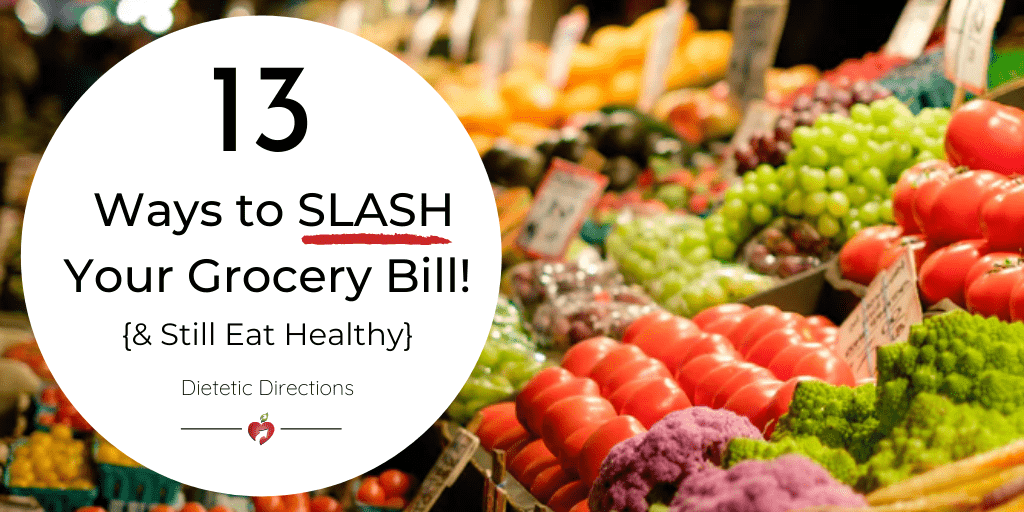
13 Ways to Slash Your Grocery Bill
Food prices have gone up considerably over the pandemic. Consequently, you’re likely wanting to Slash your Grocery Bill and Still Eat Healthy. We got you! We know this time of hardship has hit many in different ways from changing work situations, mounting stress and possible social isolation. Nevertheless, despite the various pandemic stresses and rising food prices, here are our Top 13 Ways to Slash your Grocery Bill (while Still Eating Healthy).

How Much Have Grocery Prices Increased?
Unfortunately, according to this year’s 11th annual edition of Canada’s Food Price Report, food prices will increase by 5% compared to 2020. This is based on a family of four with an annual food expenditure of around $13,000; therefore, the increase is as much as $695 a year. Without a doubt, tips to Slash your Grocery Bill are what many of us need.

13 Ways to Slash Your Grocery Bill!
1. Build Food Budget Awareness
Before we start grocery bill saving, it’s important to know how much you are currently spending and where (i.e. grocery purchases, Costco runs and/or restaurant/take-out, alcohol). Subsequently, this allows you to see where extra costs are adding up (often unknowingly). Additionally, you can use apps (check out free apps) to track grocery spending or try a simple pen and paper method. Without a doubt, it’s much easier to measure our food savings when we have a clear idea of where we are starting from.

2. Meal Plan to Waste Less Food
Basic Meal Planning is a powerful grocery-saving tip because it’s crucial for decreasing food waste and buying only what you need. This is relevant because the average Canadian household wastes over $1,766 per year (or $33 a week) on good foods – this includes leftovers and untouched food that could have been eaten at one point. Therefore, cutting down on food waste can save over 10% of your grocery bill.
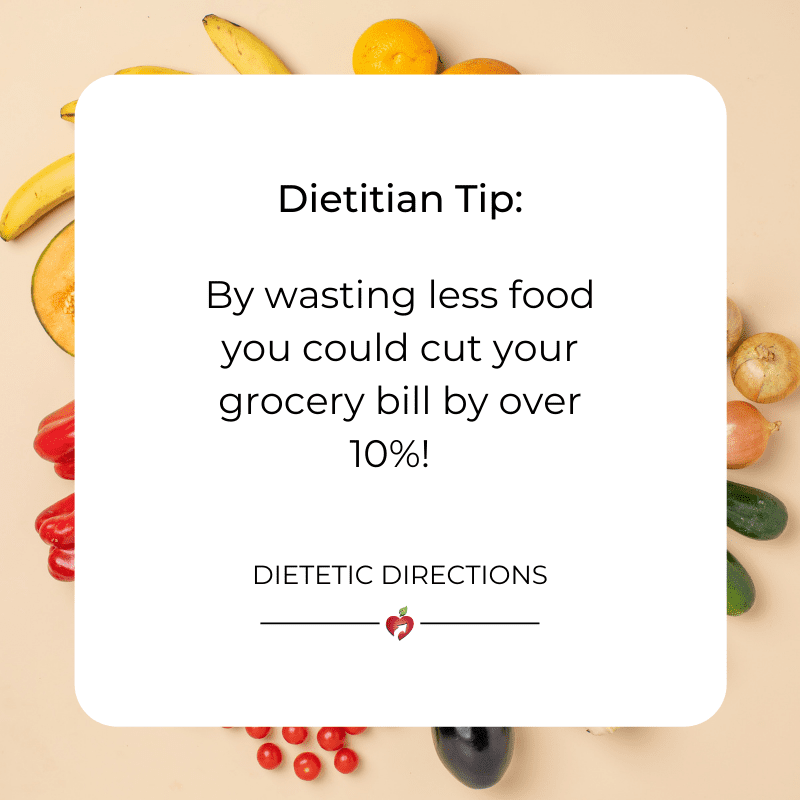
Why are we Wasting Good Food?
- Buying too much.
- Cooking leftovers without a plan to eat them.
- Improperly storing foods (a.k.a – not maximizing freezer meals).
When we are without a plan, we are more likely to throw food (or money) in the trash or resort to expensive takeout. Without a doubt, much of our household food waste is avoidable. Therefore, having a basic meal plan (or idea of what you will eat during the busy week) helps us use the foods we have already instead of throwing them out.

Meal Planning Saves $$:
To effectively meal plan, the first step is to see what perishable items you have. This needs to be done BEFORE grocery shopping and allows us to plan to use these items FIRST before fresher produce. For example, you might see spinach, mushrooms and peppers in the fridge. Write down all these perishable items to serve as meal inspiration. Then, plan a meal that uses these perishables – I love a ‘fridge cleaner’ Quiche or Stir-Fry Rice to use leftover veggies – toss in your mushroom and spinach for example. Or use leftover veggies on an Easy Naan Flatbreads, or add them to a curry or pasta sauce. Undoubtedly, having versatile recipes to use leftover ingredients helps cut down on food waste and saves money.

Here’s a free downloadable Meal Planner I created in partnership with Egg Farmers of Ontario. Use the #1 setting on the meal planner to write down foods to use up. Remember: these foods act as meal inspiration to use immediately for the week ahead.
Free Meal Planner Template
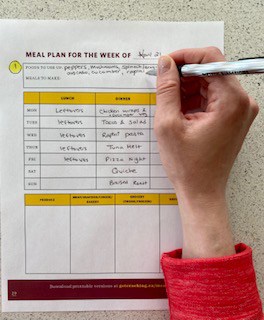
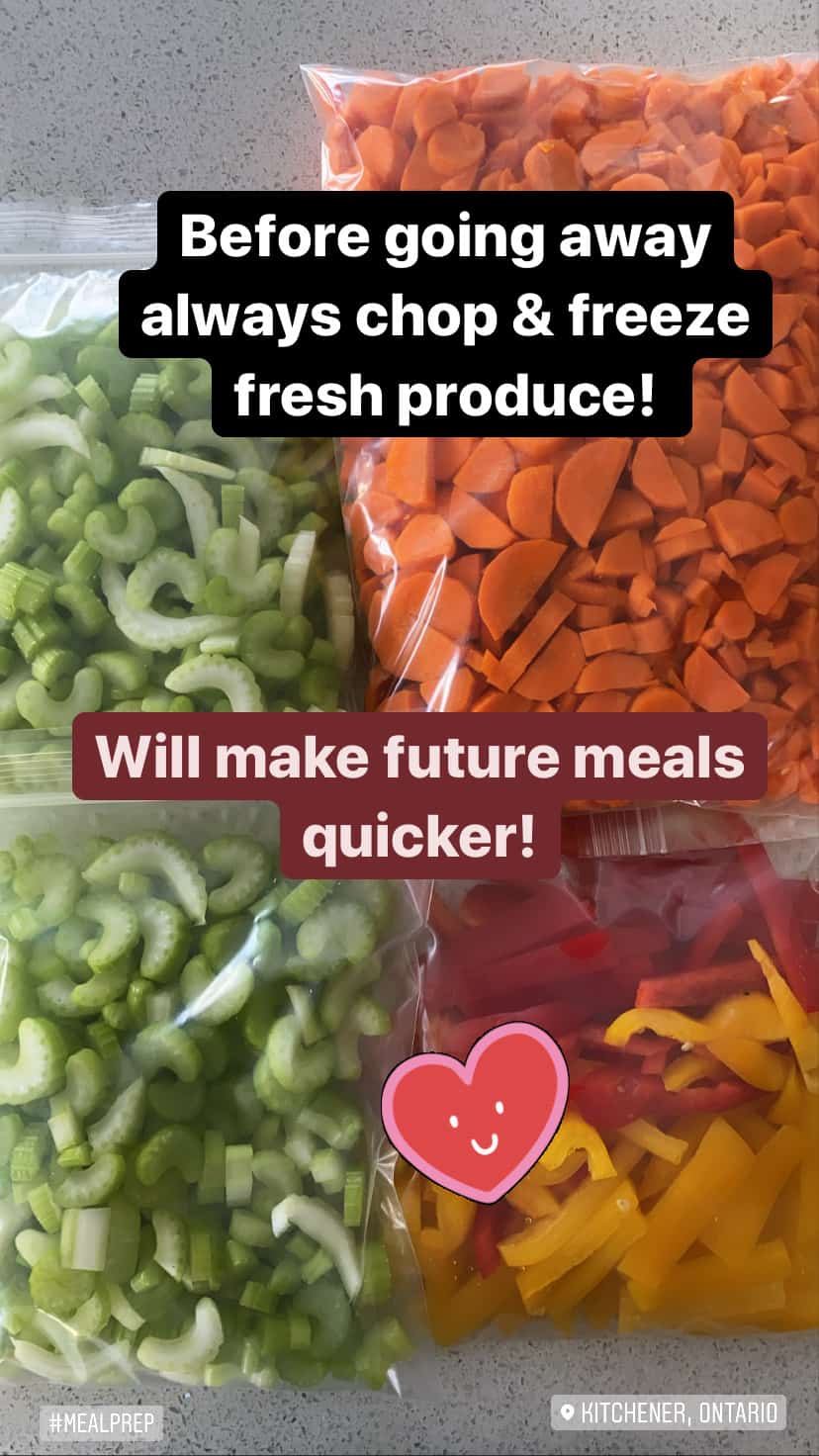
Grandma’s Mushroom, Broccoli & Cheddar Quiche

3. Grocery Lists Save Money!
The way we grocery shop can also save us money. To start, be sure to use a grocery list to save money! This makes trips faster, and you’ll buy only what you need. Additionally, using the above meal planner template, when coming up with meals for the week ahead, place needed ingredients on the grocery list at the bottom (see blank meal planner template with grocery list).
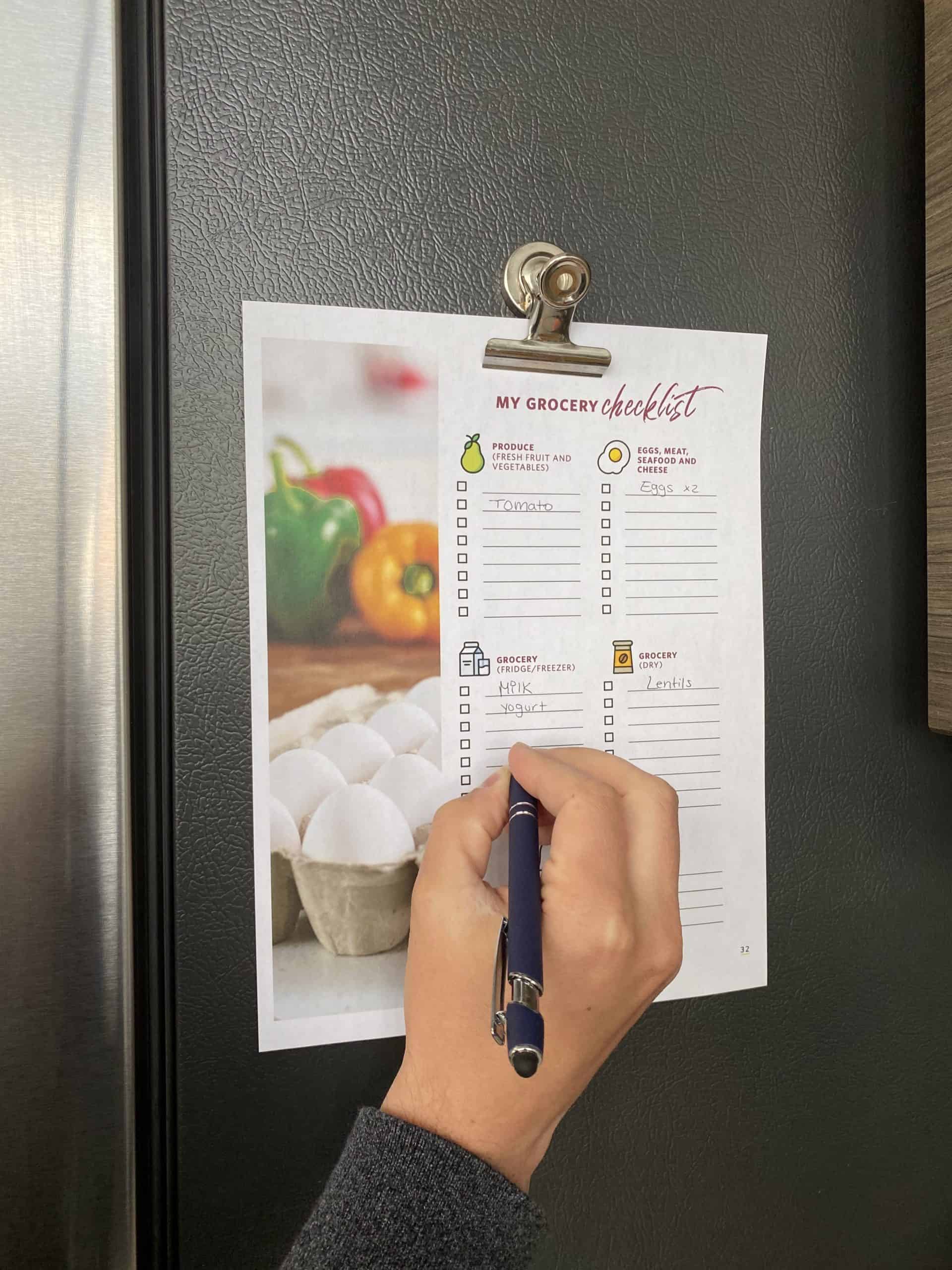
The University of Pennsylvania found that having a grocery list reduced impulse spending and can save up to 23% on your grocery bill.
4. Enjoy Inexpensive Proteins
Based on Canada’s Food Price Report (2021), the most significant food price increases are predicted for meat at 4.5 to 6.5%. This means that chicken, beef, and turkey, as well as seafood, will be most significantly impacted; plus, they’re already more expensive options. Therefore, utilize more protein alternatives (like beans, lentils, eggs, tofu, peanut butter) – they’re less inflation-prone and certainly less expensive. It’s a big way to slash that grocery bill.

In my opinion, when it comes to cheap protein sources, you can’t beat eggs. They’re loaded with 6 grams of protein per egg (half of that protein in the yolk) as well as 14 key nutrients. For example, eggs are a good source of choline vital for brain health and lutein for heart and eye health. Eggs also have a great fridge shelf-life of 3 to 5 weeks. However, in my house, a carton of eggs never lasts that long.

Eggs are Affordable!
The cost of eggs has remained stable and has not been impacted much by inflation. In fact, the average retail price for a dozen (12) eggs in Canada was $3.62 in February 2021. That works out to approximately $0.30 an egg. That’s ‘eggs-ellent’ value! I always have two cartons of eggs in the fridge that can easily turn into a quick meal. Here are some budget-friendly meal ideas:
Mini Egg Muffins

Lentil & Kale Shakshouka

Classic French Toast

Meal Themes for Dinner Ideas!

5. Try a 50/50 Meat & Lentil Mix
If you enjoy meat, you can also get creative with using a combination of meat and beans/legumes, eggs or plant-based options to extend recipe yields. For example, if making a chili or tacos, try using half the beef/chicken/turkey and mix with half (50%) lentils to off-set the protein cost, bump up the fibre and provide extra protein and vitamins to boot. Additionally, try adding whisked eggs to tofu when pan frying for a crispy coating and nutrition boost.

Tacos with Black Beans & Beef
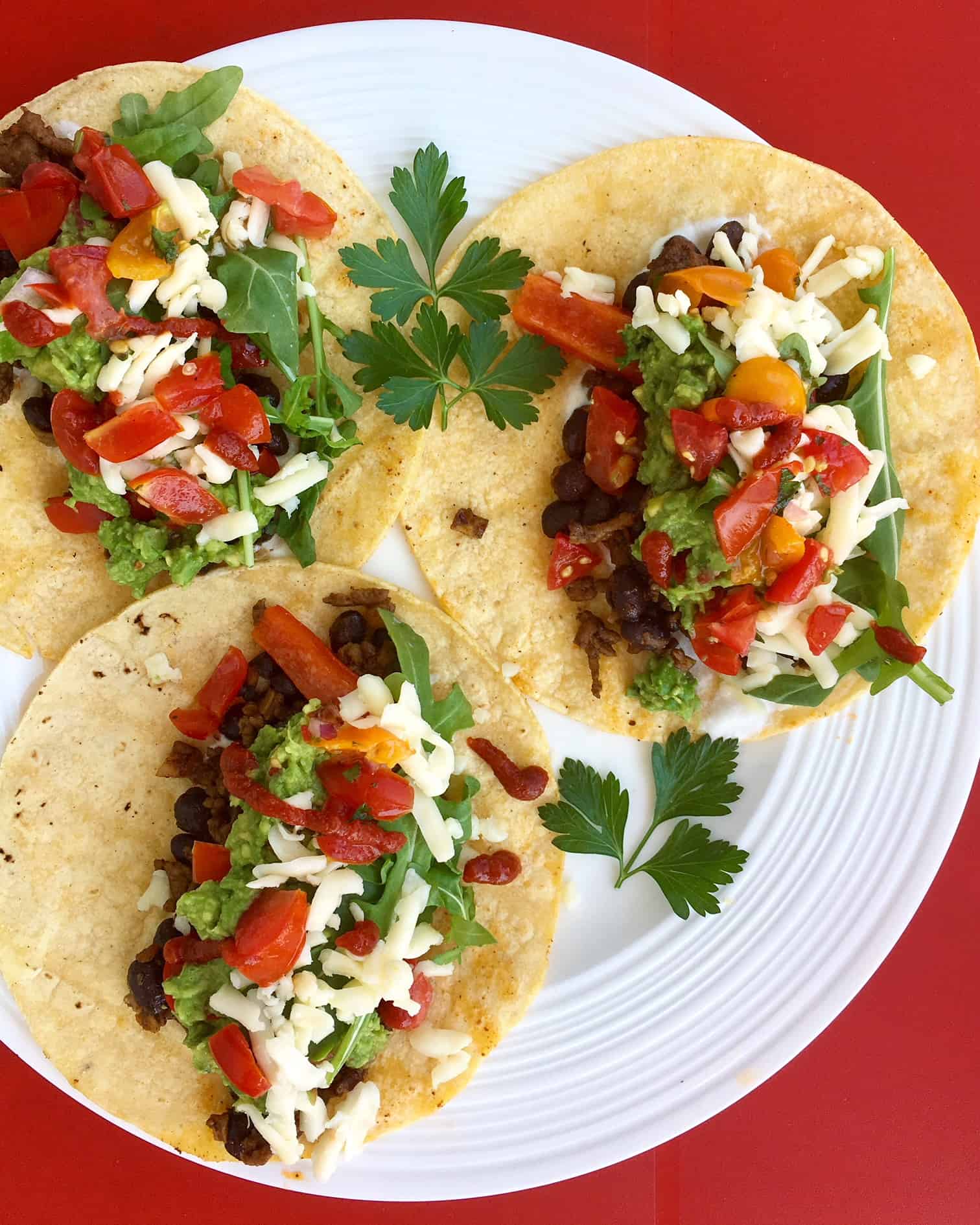
What are Lentils?
Many are unfamiliar with lentils – they are tiny, edible pulses or seeds. Think of lentils as inexpensive protein and fibre powerhouses. In fact, a small 1/2 cup of cooked lentils has 9 grams of protein and 8 grams of fibre. Nice! A can of lentils costs only around $1.20 and can be consumed on their own, or added to soups, stews/chili, casseroles, Buddha Bowls or salads to boost nutrition. Moreover, you can purchase dried lentils, and the price is even lower.

Savings TIP: If you’re a meat-eater, try mixing lentils with ground beef or sausage for sauces, tacos, chili or nachos. This doubles the yield, increases the fibre, magnesium and protein.
More Ideas? Dietetic Directions’ Budget-Friendly Eats:
Greek Lentil Salad
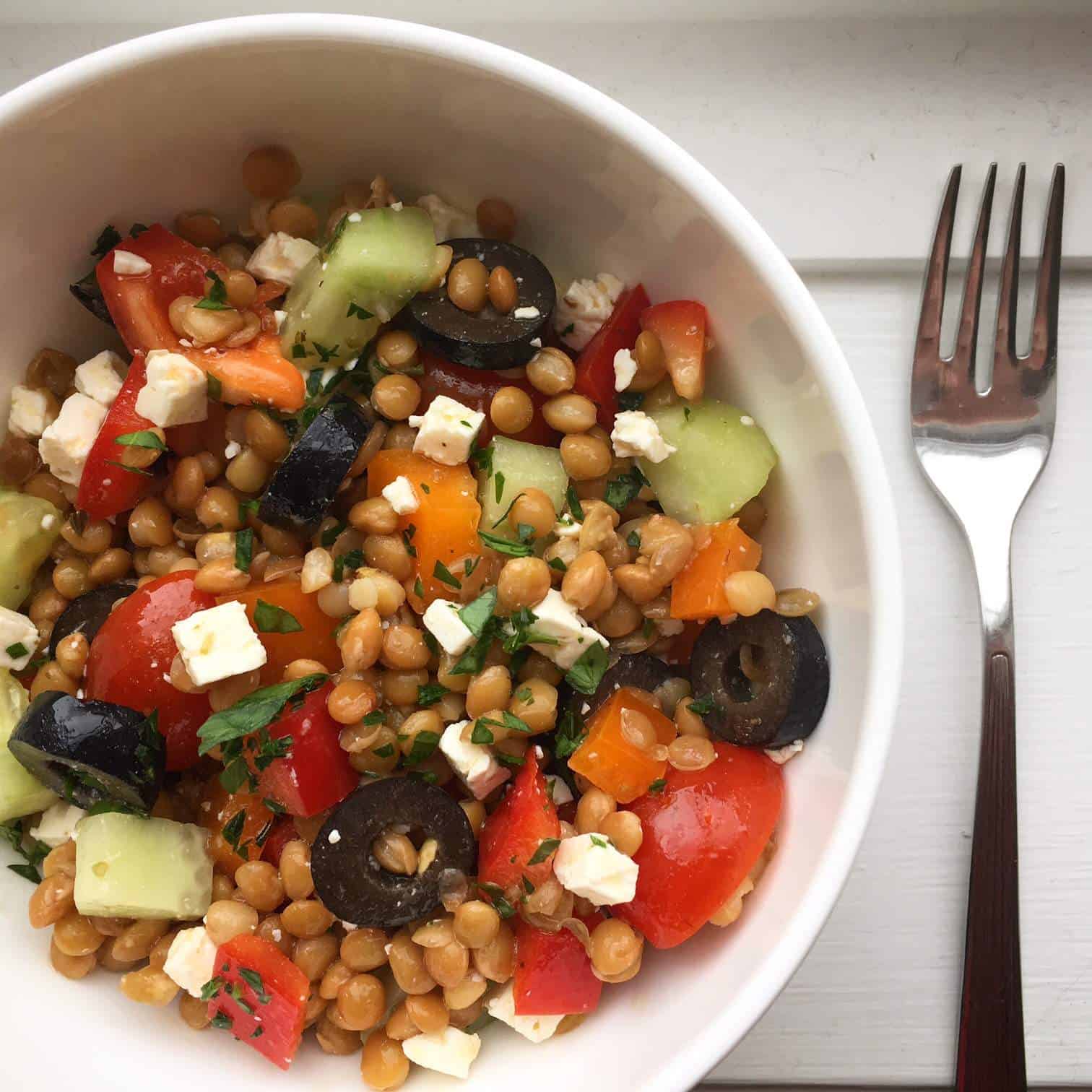
Garlicky Breakfast Lentils with Egg

Garlic Lentil Bruschetta

6. Buy Generic Brands:
Let’s stay on this grocery bill-saving train! Generic brands, such as No Name, often cost 25% less than the name brand. Some generic products may taste different,y but many are quite similar. Compare the Nutrition Facts label and ingredient lists to see how the products compare nutritionally. The higher price of the brand name often comes from the fancy packaging and the larger marketing budget. If saving 25% on a single item does not seem like much, remember that it adds up to hundreds of dollars over the year.
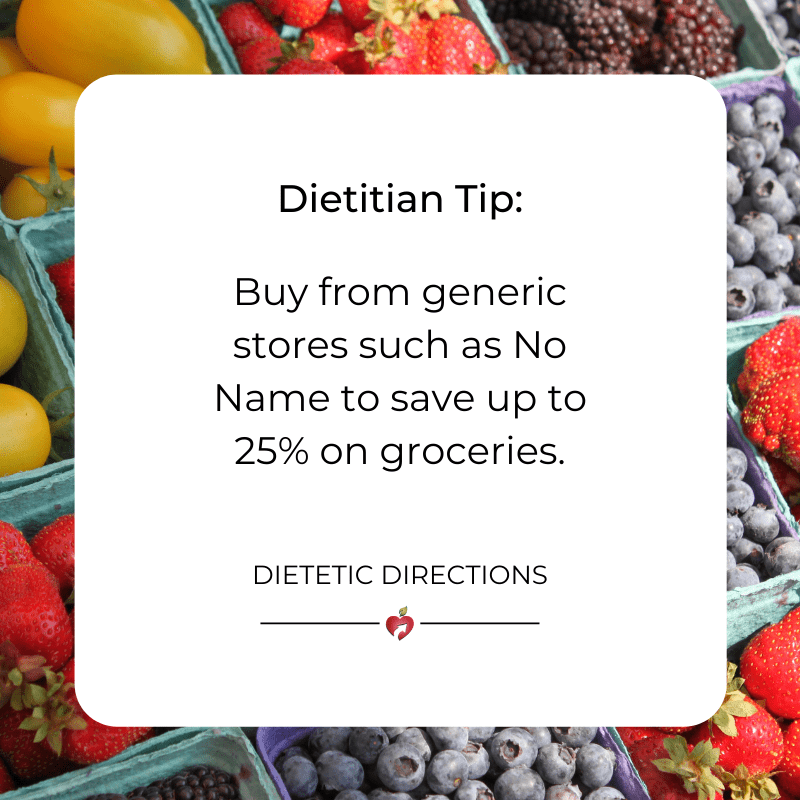
7. Shop at Discount Grocers
As a budget-conscious person, I utilize and recommend shopping at discount grocers to slash grocery spending by more than 10%. These savings could apply to identical products sold at each store. Remember, be sure to shop at a store you like and appreciate the quality of foods. Similarly, there are discount food baskets that sell ‘imperfect’ or not pretty fruits and veggies. These are great options to enjoy savings on those fresh fruits and veggies!
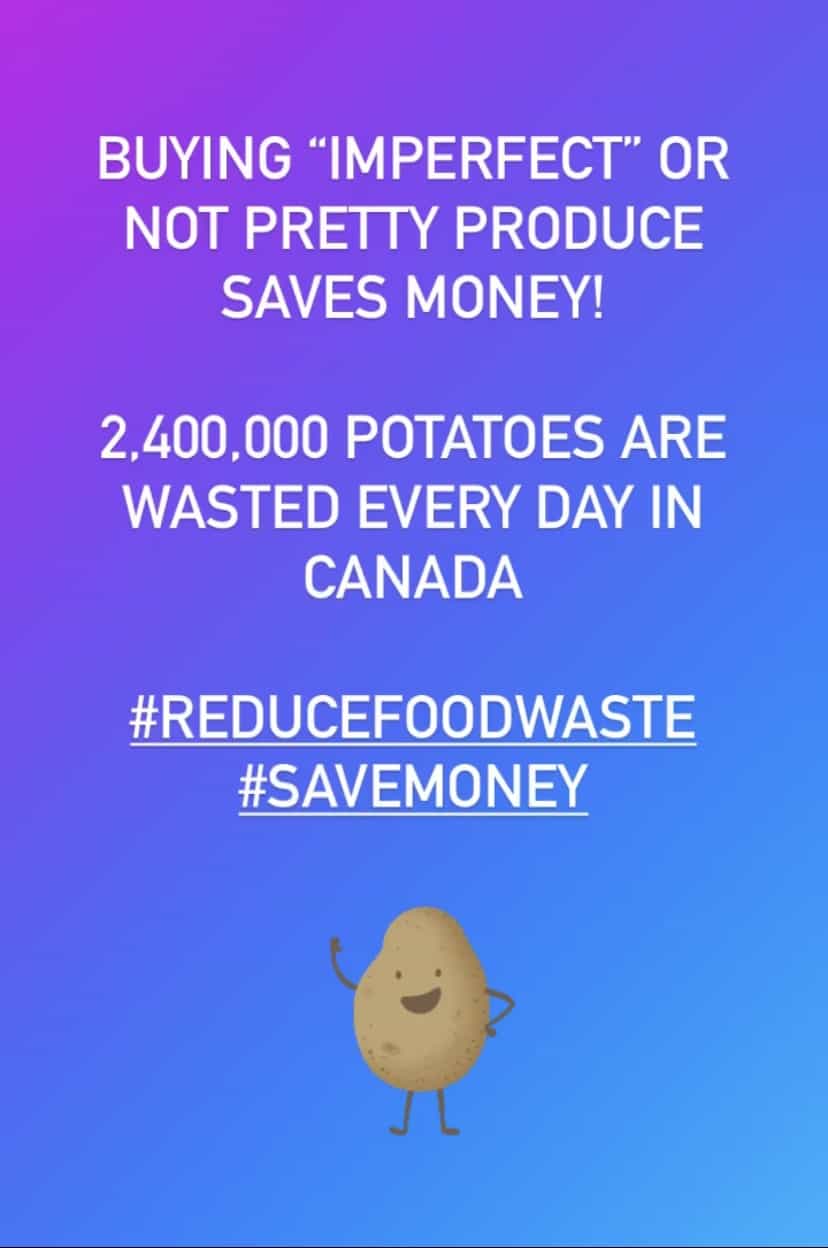
8. Become a “Sale Hunter” &/or Price Matcher:
Food prices fluctuate week to week and from grocery store to grocery store. Therefore, be sure to use free flyer apps (like Flipp) to hunt for sales when planning meals. This way, you can take advantage of big sale items when choosing your meals for the week. For example, if asparagus is in season and on sale, I am inspired to make an Asparagus Pasta, Omelette/egg casserole or my Roasted Asparagus in the oven.

How to Price Match?
Taking advantage of sales means that you may also be price-matching. If you are unfamiliar, price-matching involves showing the cashier the app (or flyer) with the lower price for a product at a competitive store. The cashier will then match the lowest price to give you the best deal. However, this option is only available at some discount grocery stores (like Superstore, FreshCo and Walmart).

9. Cook More!
Cooking your own meals is one of the biggest ways that you can save. Prepared foods, meal kits, restaurant meals and takeout all cost more. Additionally, cooking meals at home is associated with improved nutrition with fewer calories, fat, salt and more fruits, veggies and fibre. What’s more, if you are in the habit of cooking more, you can further the savings by cooking batches for the freezer! This way, you can enjoy pre-portioned leftovers for lunches or dinner. Interestingly, if you avoid buying lunch at work this could save you around $1800 a year.
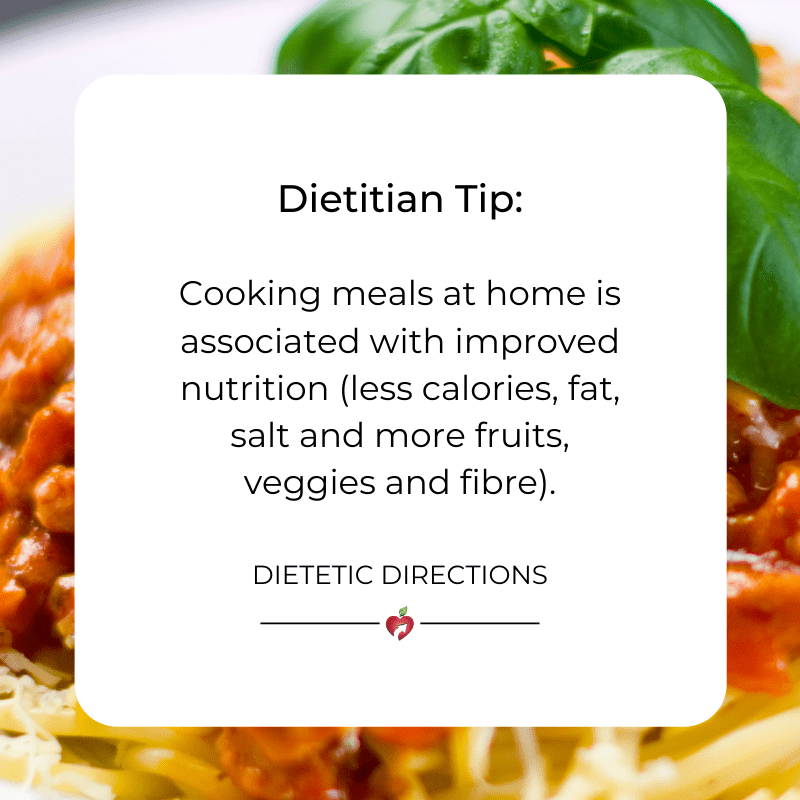
10. Never Grocery Shop Hungry
The next grocery-saving etiquette tip is something we have likely all experienced at one point. Never shop hungry! Consequently, we know that this can lead to spending more, buying more impulse items and straying from a budget or shopping list. Instead, grocery shop after you’ve had a complete meal or a power snack. Your wallet will thank you.

11. Utilize Frozen, Canned & In-Season Produce
You do not have to cut down on fruit and veggies if on a budget. In fact, shopping sale items or front-page flyer items makes for big savings on produce. These are often in-season, which means they travel less distance from farm to grocery store. Therefore, front flyer discounts can inspire your produce choices and save you more.

Taking advantage of frozen fruits or vegetables (especially when they go on sale) is another money-saving trick that does not compromise nutrition. Frozen peas, edamame, cherries and peaches are staples in my house. The veggies are perfect for adding to entrees, and the fruits to oatmeal, yogurt parfaits or smoothies. Interestingly, both frozen and canned veggies and fruits are still nutritious and available all year long. Find out more about the nutrition of canned foods and frozen fruits and veggies.
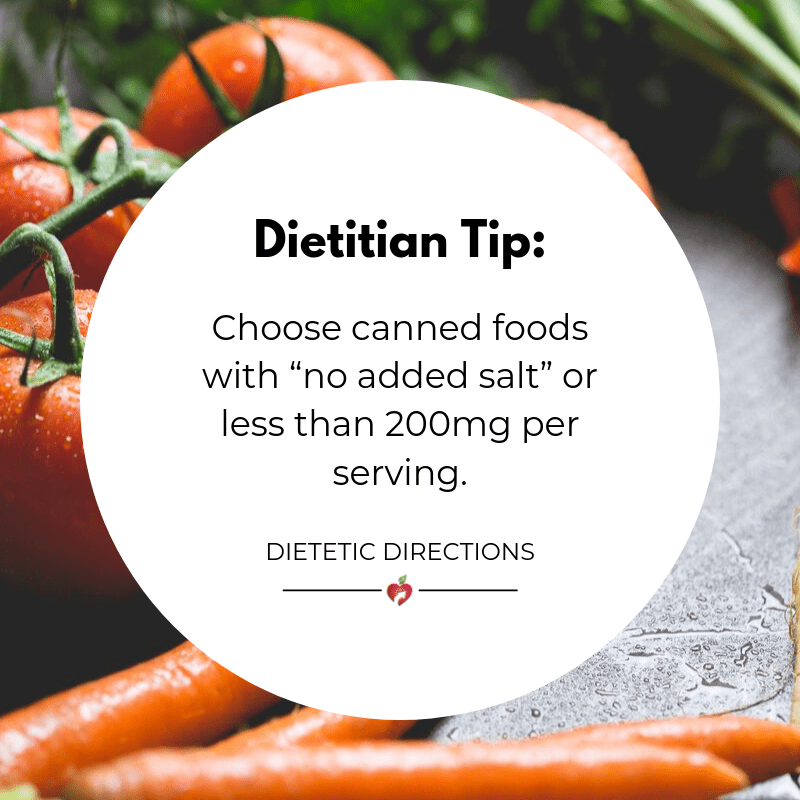
12. Shop Once Weekly (& Ideally Alone)
Simply put, the less you’re shopping, the more you’re saving. By shopping only once a week you’ll reduce impulse purchases and save time and gas too. Plus, it will get you into the habit of planning ahead for the whole week, using up foods and perhaps inspire you to organize meals in advance. Similarly, here again is a free comprehensive resource on How to Meal Plan Like a Pro to focus your grocery trips on meals you will make. Additionally, shopping on your own (without kids or spouse) is more conducive to staying focused with grocery list and avoiding impulse purchases.

13. ‘Shop’ Your Pantry & Freezer
This is my last and probably favourite Grocery Saving Tip. At least once a month, or even quarterly, go through your freezer and pantry and ‘take stock’ of what you already have. This way you won’t impulse-buy items you already have and won’t be wondering about what else you might need. This tip is key to reducing food waste and promotes only buying what you need, which, of course, slashes your grocery bill!

Pantry Peak
Before grocery shopping, take a look in your pantry to see what you have. I recommend using an organization sheet to write down what you have along with a couple of meal ideas. For example, I have tuna cans (*6) – could make tuna wraps, tuna melts, cold tuna pasta salad, tuna on crackers. Now, all I have to do is figure out when I want to use the tuna during the busy work week and that I have all necessary ingredients. Perhaps I want to use a ‘meal theme’ and call it Tuna Tuesdays to inspire me to use up this tuna! Focusing first on what you have to use and second on creative ideas to use these ingredients ensures we use what we have first.
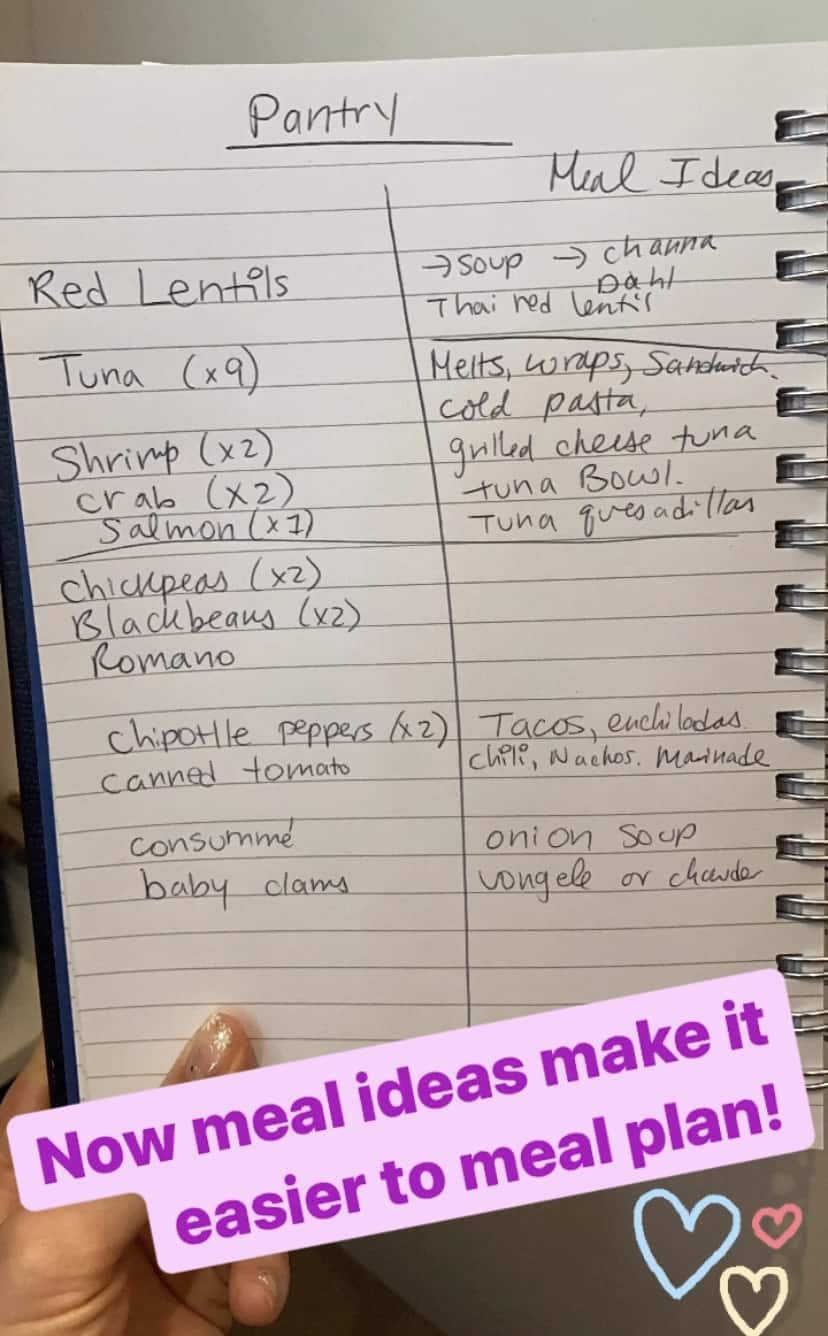
Meal Ideas are GOLD!
Remember that meal ideas are gold. They can be very difficult to come up with, and they provide focus when meal planning for the week or night ahead. Mealtime stress goes from “I have no idea what to make” to “I got this!”

Freezer Inventory
When was the last time you took a thorough look at your deep freezer? Probably over six months? Over one year? Okay, this is a cost-saving trick – go into the freezer and organize what you have on hand! USE IT UP! Panic buying was very real during the pandemic and caused people to furiously stock away foods. This also caused people to spend more money and have food go bad after being stashed away.

Bottom Line:
Despite the rising food prices, there are effective ways to stretch our food dollar and slash our grocery bill. Therefore, some of the top saving strategies include: review your food spending, implement basic meal planning, use a grocery list, enjoy inexpensive proteins, mix meat with beans/lentils, buy generic brands, shop discount grocers, maximize sales and price-matching, cook more at home, use canned and frozen produce, shop once weekly and not when hungry. Finally, be sure to take an inventory of your pantry and freezer to use these items.
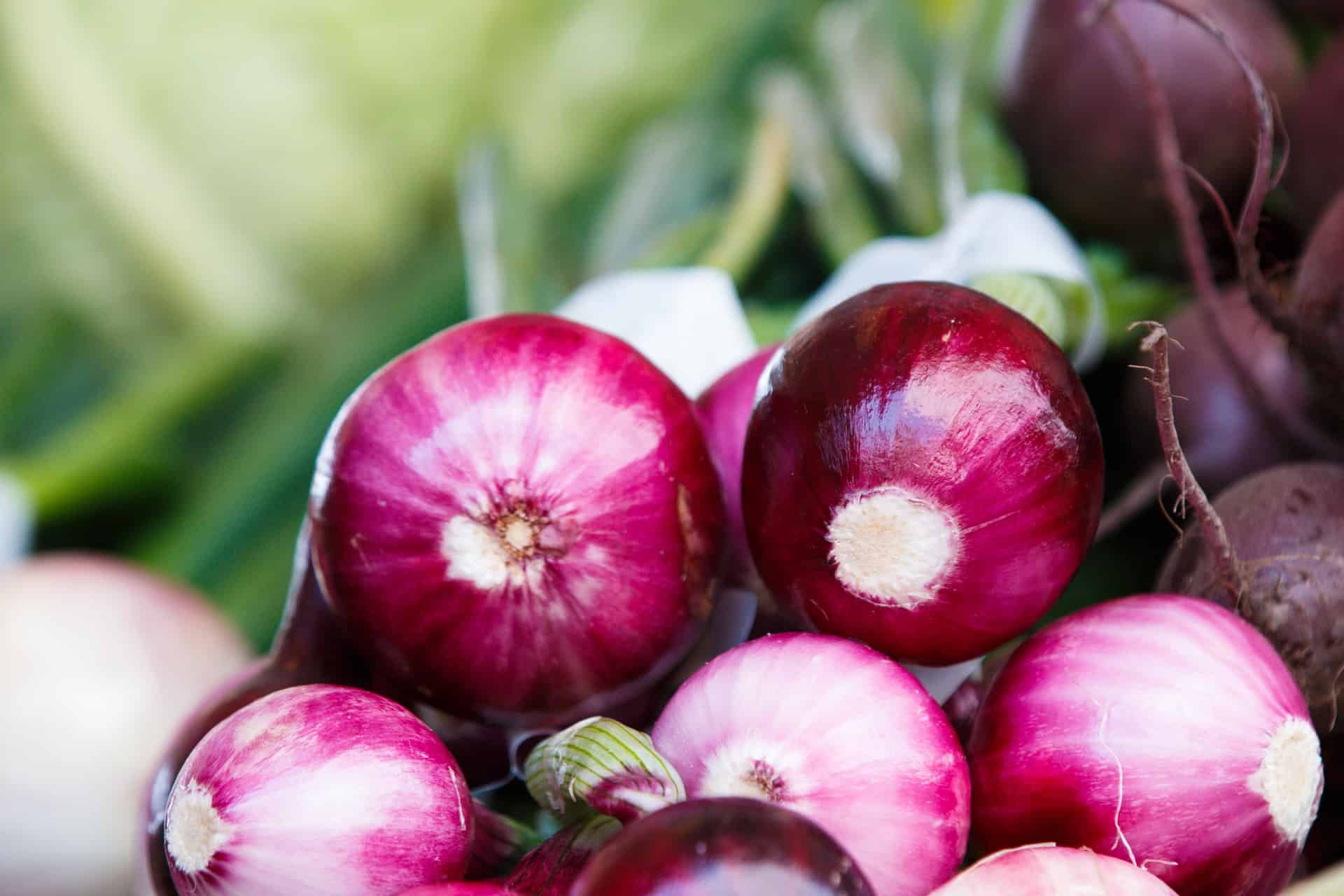
We hope you enjoyed this blog on 13 Ways to Slash Your Grocery Bill. Be sure to share with friends or family who would enjoy saving tips. Above all, during the pandemic and afterwards, if you are in a place of privilege and can afford to help others, be sure to donate to the Food Bank.



